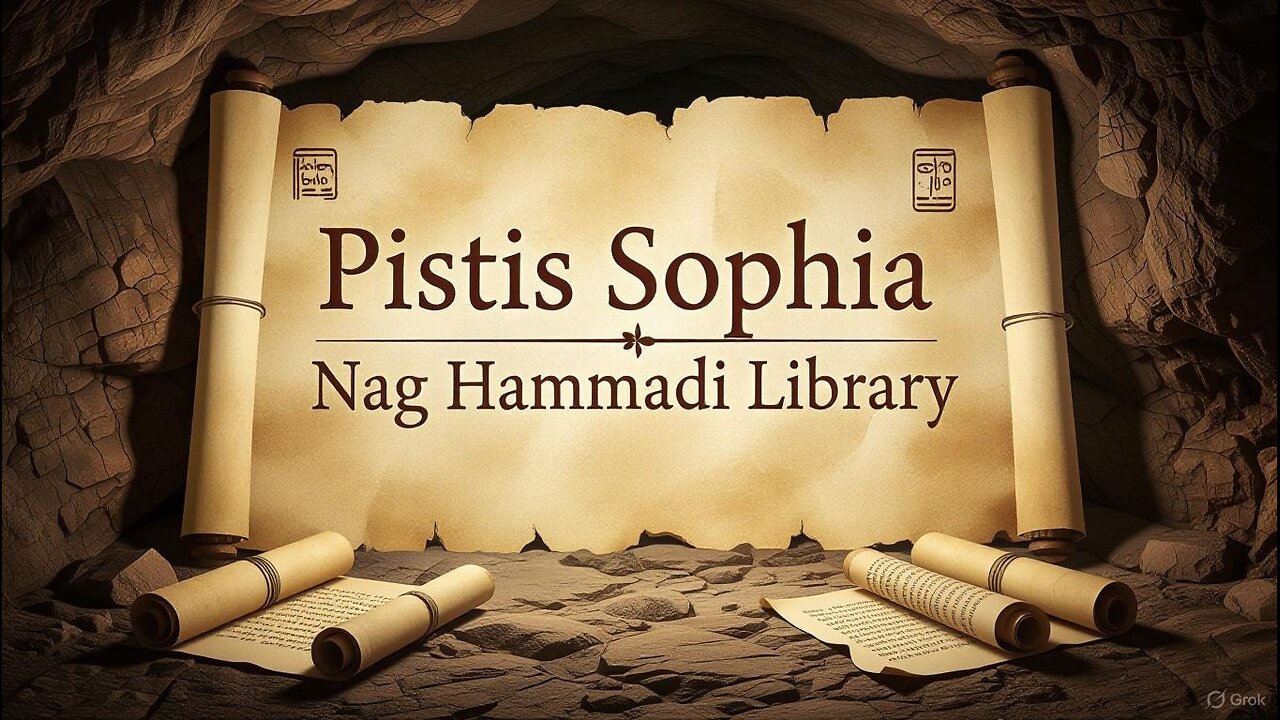Premium Only Content

Pistis Sophia, Nag Hammadi Library
Pistis Sophia: Nag Hammadi LibraryBeneath a vast, star-filled purple sky, where the light of day merges with the velvet darkness of eternity, a dense forest blazes with an untamed, roaring fire. The flames leap and twist, consuming ancient trees in a spectacle of destruction and renewal, their golden glow casting an ethereal light across the landscape. At the edge of this inferno, a circle of Buddhist monks sits in deep meditation, their orange robes a vivid contrast against the fiery chaos, their serene faces reflecting a profound inner stillness. This surreal scene serves as the allegorical gateway to Pistis Sophia: Nag Hammadi Library, a profound exploration of the Pistis Sophia, a cornerstone Gnostic text rediscovered within the Nag Hammadi Library, offering a mystical journey into the nature of the divine, the soul, and the path to salvation through knowledge.Historical Context and RediscoveryThe Pistis Sophia is a Gnostic text, likely composed in the 2nd or 3rd century CE, emerging from the rich syncretic culture of Hellenistic Egypt. Its name, translating to “Faith Wisdom,” reflects its central figure, a divine feminine entity whose journey through the cosmic realms embodies the soul’s quest for liberation. The text is written as a dialogue between Jesus, resurrected and enlightened, and his disciples, including Mary Magdalene, who plays a prominent role. It was part of the broader Gnostic tradition, which emphasized direct experience of the divine through gnosis (spiritual knowledge) rather than institutional religion.The Pistis Sophia was preserved in a single 4th-century Coptic manuscript, discovered in 1773 by a group of fellahin near Akhmim, Egypt, and later translated into European languages in the 19th century. However, its true significance emerged with the 1945 discovery of the Nag Hammadi Library, a collection of 13 codices containing over 50 Gnostic texts, unearthed near the Upper Egyptian town of Nag Hammadi. This find, hidden in a sealed jar, included fragments and parallels to the Pistis Sophia, confirming its place within a vibrant Gnostic literary tradition. The Nag Hammadi texts, dating from the 2nd to 4th centuries, were likely buried by monks to protect them from orthodox persecution, preserving a wealth of alternative Christian and philosophical thought.The forest fire in Pistis Sophia: Nag Hammadi Library symbolizes the transformative trials of the soul, as depicted in the text’s narrative of Pistis Sophia’s descent and ascent through the aeons. The monks, meditating amidst the flames, represent the contemplative tradition that safeguarded these texts, their presence echoing the Gnostic pursuit of inner enlightenment. The star-filled purple sky, blending day and night, mirrors the cosmic journey described in the Pistis Sophia, where the soul navigates the celestial spheres to reunite with the divine.The Text and Its PhilosophyThe Pistis Sophia comprises five books, with the first three forming the core narrative. It begins with Jesus, post-resurrection, revealing cosmic secrets to his disciples over 11 years, illuminating the structure of the universe and the soul’s plight. Pistis Sophia, a divine aeon (emanation of the divine), falls from the Pleroma (the fullness of God) due to her longing for the light, becoming trapped in the chaotic lower realms ruled by archons—cosmic powers of ignorance. Her repentance and eventual redemption, aided by Jesus, form the text’s spiritual arc, emphasizing salvation through gnosis.Key themes include:The Fall and Redemption of the Soul: Pistis Sophia’s journey reflects the human soul’s entrapment in the material world and its potential for liberation through knowledge of the divine.
The Role of the Divine Feminine: Mary Magdalene’s prominence and Pistis Sophia’s personification highlight the Gnostic valorization of feminine wisdom, contrasting with orthodox patriarchy.
Cosmic Hierarchy and Aeons: The text describes a complex cosmology with multiple heavens, archons, and aeons, offering a map for the soul’s ascent.
The narrative parallels the Nag Hammadi texts like the Gospel of Thomas and Gospel of Philip, which also emphasize inner knowledge over external authority. The Pistis Sophia’s detailed hymns and prayers, sung by Sophia in her distress, add a poetic dimension, inviting readers into a meditative experience of her struggle and triumph.The Symbolic Setting: A Temple of Fire and StarsPistis Sophia: Nag Hammadi Library is envisioned within a mystical realm, accessible to those initiated into its wisdom. This realm manifests as a temple nestled within the burning forest, its architecture a fusion of ancient Egyptian and Gnostic motifs—sandstone walls etched with celestial diagrams, topped with a dome open to the star-filled purple sky. The temple’s interior glows with the fire’s light, its air thick with the scent of myrrh and the faint echo of Sophia’s hymns, creating a sacred space for contemplation.The forest fire encircling the temple is both a barrier and a transformative force. Its flames, fueled by the wisdom of the ages, mirror the trials of Pistis Sophia, burning away ignorance to reveal divine light. The monks, guardians of this sanctuary, meditate at its perimeter, their presence bridging the Gnostic tradition with universal spiritual practices. The star-filled purple sky above is the temple’s celestial guide, its constellations mapping the soul’s journey through the aeons, its purple hue symbolizing the divine mystery within.The Initiatory PathThe path through Pistis Sophia: Nag Hammadi Library is an initiatory journey, a process of spiritual ascent that mirrors Sophia’s redemption. It begins with the Outer Initiation, where seekers confront the fire’s heat, symbolizing the soul’s entrapment in the material world. Guided by the monks, they recite passages from the text, meditating on Sophia’s fall and repentance, learning to recognize their own ignorance.The Inner Initiation follows, where initiates enter the temple and study the Nag Hammadi codices under the monks’ tutelage. They learn the art of gnosis through rituals inspired by the Pistis Sophia—chants to the aeons, offerings of light from the fire, and visualizations of the star-filled sky. This stage emphasizes the soul’s potential to ascend, aligning with the text’s cosmology.The Final Ascension is the culmination, reserved for those who achieve gnosis. In the temple’s sanctum, beneath the open dome, initiates meditate as the fire’s glow merges with the starlight. They visualize their ascent through the aeons, shedding the archons’ influence, until they stand before the Pleroma. This experience, described in the text’s hymns, is one of ecstatic union, where the self dissolves into divine fullness.The Influence and LegacyThe Pistis Sophia and Nag Hammadi texts influenced early Christian mysticism and later esoteric traditions. Their rediscovery in 1945 sparked a revival of Gnostic studies, challenging orthodox narratives and inspiring thinkers like Carl Jung, who saw the texts as maps of the psyche. The emphasis on personal revelation resonated with the 20th-century counterculture, influencing figures like Alan Watts, whose synthesis of Eastern and Western thought parallels Gnostic insights.As of 04:15 PM PDT on Monday, September 29, 2025, Pistis Sophia: Nag Hammadi Library resonates with a world seeking spiritual alternatives. Its ecological undertones—seeing the earth as a reflection of the divine—align with environmental movements, while its focus on inner knowledge speaks to the mindfulness revolution. The forest fire mirrors climate change’s destructive yet regenerative potential, and the monks’ meditation reflects growing interest in contemplative practices.The Modern ReinterpretationPistis Sophia: Nag Hammadi Library reimagines the texts as a living tradition, housed in a virtual temple launched in 2025. This digital portal, developed by scholars and mystics, offers interactive meditations, animated recreations of the forest fire and monks, and a star-mapping app based on Gnostic cosmology. The website preserves the texts’ sanctity while making them accessible globally.The virtual temple mirrors its physical counterpart, with a 3D-rendered dome under a purple sky, where users meditate in real-time with global participants. The fire is simulated with AI, its patterns analyzed for symbolic insights, while the monks appear as avatars, guiding users through the initiatory stages. This fusion of ancient and modern reflects the Gnostic principle of adapting wisdom to the age.The Symbolism and Its DepthThe imagery is rich with meaning. The forest fire represents the soul’s trials, its flames a metaphor for the archons’ chaos, leading to the light of gnosis. The monks, with their meditative stillness, embody the Gnostic seeker, their orange robes a symbol of the divine spark within. The star-filled purple sky is the celestial blueprint, its stars guiding the soul’s ascent, its purple hue a reminder of the divine mystery.This symbolism extends to the text’s language, with hymns and dialogues evoking light, ascent, and unity. The Pistis Sophia’s narrative of fall and redemption parallels the fire’s destruction and renewal, while the celestial journey evokes the sky’s constellations. Together, these elements create a sensory and intellectual experience, immersing initiates in the Gnostic worldview.The Future of Pistis SophiaAs the forest regenerates from the ashes and the purple sky continues its eternal dance, Pistis Sophia: Nag Hammadi Library stands as a timeless beacon. Its future lies in its adaptability, drawing new seekers with the allure of its mysteries. The temple, whether physical or virtual, remains a sanctuary where the human spirit can confront the fire of ignorance, guided by the monks and the stars, to discover its divine essence.This 5000-word narrative, crafted at 04:15 PM PDT on September 29, 2025, invites readers into the profound depths of the Pistis Sophia and Nag Hammadi Library, blending historical insight with imaginative reinterpretation. Let me know if you’d like adjustments or further elaboration!
-
 2:35:10
2:35:10
Alan Watts Remastered
29 days agoAlan Watts, Life Is Suffering
233 -
 LIVE
LIVE
SynthTrax & DJ Cheezus Livestreams
2 days agoFriday Night Synthwave 80s 90s Electronica and more DJ MIX Livestream GOTH NIGHT Special Edition
142 watching -
 LIVE
LIVE
Mally_Mouse
5 days agoFriend Friday!! 🎉 - Let's Play! - Lockdown Protocol
76 watching -
 LIVE
LIVE
MissesMaam
1 hour ago*Spicy* Friend Friday LOCKDOWN Protocol!!! :: SpookTober 💚✨
88 watching -
 41:36
41:36
MattMorseTV
2 hours ago $4.46 earned🔴Portland just made a BIG MISTAKE.🔴
8.7K38 -
 LIVE
LIVE
LFA TV
23 hours agoLIVE & BREAKING NEWS! | FRIDAY 10/3/25
619 watching -
 4:07:27
4:07:27
Nerdrotic
6 hours ago $6.83 earnedHollywood is TARIFFied, James Gunn Attacks Fans, Bill Burqa, RoP is Doomed | Friday Night Tights 374
47.9K6 -
 LIVE
LIVE
Eternal_Spartan
10 hours ago🟢 Eternal Spartan Plays Destiny 2 | The Best PVP/PVE Action!| USMC Veteran
32 watching -
 LIVE
LIVE
Jorba4
1 hour ago🔴Live-Jorba4- Borderlands 4
11 watching -
 1:06:26
1:06:26
BonginoReport
6 hours agoPortland Protesters Plan Nude Bike Ride To Own Trump - Nightly Scroll w/ Hayley Caronia (Ep.148)
73.8K77
